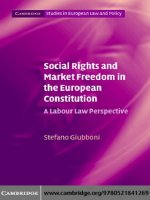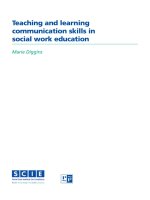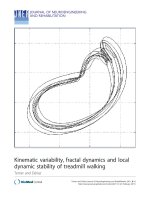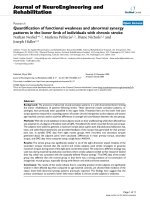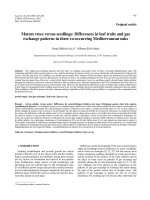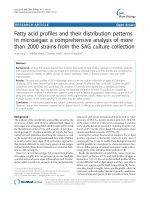Social dynamics and local trading patterns in bantaeng region, south sulawesi (indonesia) circa 17th century 1
Bạn đang xem bản rút gọn của tài liệu. Xem và tải ngay bản đầy đủ của tài liệu tại đây (6.54 MB, 63 trang )
1
Chapter 1
Introduction
Studies of material culture support research on relations between various groups of
people and cultures and their environment. Imported goods are used not only in daily activi-
ties but also to support attempts to acquire political power, and social and religious status.
Conclusions drawn from the study of material culture can be used to interpret the influence
of external cultures upon local culture and the processes by which people adapt to new
stimuli and conditions. Therefore, a study of material culture helps in understanding cultural
contact and also how people adapt to external influences. However, cultural contact should
not be viewed purely from the standpoint of contact between local and non-local culture
intertwined with the environment. Contacts and relations between groups of people in the
local region and how they adapt to the environment, including responses to threats and
dangers, are also important. Geographical conditions must be taken into account in ac-
counting for the movement of people and goods, and also for the growth of settlements and
centers of activities. In addition, a more detailed understanding of development in a region
can be used to interpret the development of wider areas.
Travelers and traders have recorded much evidence for varied and specific cultural
developments in Southeast Asia. A combination of European and Chinese records is basic
to the understanding of the Nanhai or Nanyang (South Seas-Southeast Asia) area. How-
ever, historical sources alone are insufficient to define the relationship between migration
and cultural development; archaeological research is of particular importance in this region.
2
Sa Huynh and Dong Son bronze technology (Bellwood 1985; 2000), Indian artifacts
(beads, seals, religious statues), inscriptions in Sanskrit, Chinese goods such as silk, coins,
and porcelain reached Southeast Asia through trade, which reached its peak in the 16
th
and
17
th
centuries when the Europeans became involved in a Southeast Asian trading network.
The development of settlements and states, especially along the coast, paralleled the in-
crease in overseas transportation and trade links, and this development was recorded by
European traders who reported their observations on ports (Cortesao 1944; Meilink-Roelofsz
1962, 1970; Sutherland and Bree 1987; Reid 1988; 1992, 1993a, 1993b; Nayati 1994;
Tarling 1992). Forest products of the Indonesian Archipelago had become well known in
Asia and Europe since the first century A.D. at the latest (Cortesao 1944; Meilink-Roelofsz
1962; Wolters 1967; Hall 1981; 1992; Reid 1988, 1992b, 1993a, 1993b; Tarling 1992;
Swalding 1996; Bulbeck, Reid, Tan and Wu 1998).
Studies of migration and cultural contact have tended to emphasize the role of inter-
national trade and have neglected local economic systems. Such economic systems, too,
are often treated in isolation from local political and social systems, although such studies
should clearly be interrelated (Binford 1996; Schortman and Urban 1996, Junker 1990a,
1990b, 1994). Economic systems seem to have been significantly intertwined with other
systems, and trading networks should be seen also as including social and religious activities
encompassing considerable political involvement of the elites.
Moreover, an economic system does not only affect people in political centers. The
existence of Buddhist candi in Sumatra, the Kutei Sanskrit inscription (Kalimantan Selatan)
and the use of the title raja reinforce the conclusion that commercial activity is connected
with cultural exchange. The distribution of porcelain and Hindu-Buddhist symbols found in
3
sites within Southeast Asia, especially in the Indonesian Archipelago, provides evidence of
intensive contact in the late pre-European and early European contact periods (14
th
to 17
th
centuries) between coastal and interior peoples, such as the discovery of Buddhist images in
south Sulawesi—at Sempaga (west coast of south Sulawesi, and Takalar (south coast of
South Sulawesi—west of Bantaeng region), bronze drums in Kei island (Maluku). These
objects were not found in modern administrative centers but in smaller settlements.
Archaeological evidence of contact and exchange can be found in many sites in In-
donesia, each of which has distinctive features in terms of quantitative and qualitative data.
This evidence can be correlated with differences in intensity of contact, distance from main
trade routes, time period, availability of socioeconomic networks, and character of the en-
vironment (Steward 1953, 1955; Renfrew 1975; Hughes 1977; Hutterer 1977; Gudeman
1986; Brumfiel and Earle 1987; Dora 1997). Different areas of the Archipelago experi-
enced different levels of socioeconomic complexity because of many factors including local
resource distribution and topography, which in turn affected the nature of contact with for-
eign traders. Resources from the periphery were withdrawn for consumers in the centre
(Miksic 1979; Champion 1989; Junker 1990a, 1990b; Peregrine 1996; Renfrew 1996;
Swalding 1996). Contacts between resource-providing areas and outsiders who sought
these resources have affected local cultures. The role of the individual as the main agent of
adaptation has also been very significant (Ellen 1982; Barret 2000; Brumfield 2000; Nayati
2001a).
Political and ethnic boundaries are difficult to define archaeologically as similar ar-
chaeological assemblages can be found in different regions as a result of the movement of
people across the land barriers. Similar artifacts have been reported both in coastal and
4
inland areas. Chinese porcelain of the Indonesian Classic Period (8
th
to 15
th
centuries) has
been found in temples in hinterland central Java (such as in Borobudur, Plaosan, Sewu) and
Sumatra (Padang Lawas and Padang Roco) as well as lowland habitation sites in Sumatra
(Jambi, Palembang, Riau, and Kota Cina) and Java (Trowulan) (Miksic 1979; McKinnon
1984; Atmosudiro and Nugrahani 2002). During the early Islamic Period, Chinese and
Vietnamese porcelains were used as decoration in mosques in north coastal Java (Demak,
Kudus) and south Sulawesi, and as decoration in Islamic graveyards in hinterland east Java
and south Sulawesi. In early Islamic capital cities, both in coastal and hinterland areas (such
as Banten, Cirebon, Demak, Kotagede, Plered, Kartosura, Surakarta, Yogyakarta, Trowulan,
and Sumenep, Palembang, Jambi, Singkawang, Banjarmasin, Tenggarong, Gowa, Bone,
Ternate, and Tidore), porcelain has also been recorded. Porcelain is also found in settle-
ments in South Sulawesi, Maluku, Irian (Papua), Lesser Sunda, Java, Kalimantan, and
Sumatra. The existence of porcelain of similar types and dates in different areas within the
Indonesian Archipelago is proof that the movements of goods and people were not re-
stricted by geographic, political, or ethnic boundaries.
In some areas, local religions blended with Hindu, Buddhist, and Islamic religions to
form new systems. In other areas, local people had little contact with imported faiths. Inland
cultures in Indonesia have often been largely studied in the context of their political and
social systems without acknowledging the economic systems involved. The role of hinter-
land groups in distributing material culture has been generally neglected by previous genera-
tions of archaeologists. What is interesting is that hinterland groups often remained culturally
separate from lowlanders while uniting with them in a single complex economic network.
5
Indonesian archaeology has concentrated mainly on single sites. Regional studies have
been neglected. Regional studies are necessary for understanding cultural evolution, be-
cause connections between sites and artifacts in different sites are not isolated, but are
representatives of long-term processes and can provide data on many variables. In future
one hopes that more studies will concentrate on the connections between sites on different
islands, and between coastal and hinterland regions.
Another deficit which this study hopes to ameliorate is the fact that archaeological
study in Indonesia is still concentrated in Java. Little archaeology has been done in Sumatra,
Bali, Sulawesi and eastern Indonesia. As a result, the archaeography of Indonesia is still
mostly about pre-modern Java. Indonesian children only study the history of sites in Java,
such as Prambanan, Borobudur, Sangiran, mosques and churches. Information on old
churches in Ambon, or old mosques in Ternate, or such commodities as sandalwood and
gaharu is not widely known. In reality many east Indonesian commodities were important in
the past, but it seems as if the achievements of east Indonesia are not worthy of comparison
with Javanese culture.
Previous studies of capital cities in pre-modern Indonesia have attempted to under-
stand urban physical and social structures but have not yet focused on the relations between
the old capitals with their hinterlands, which presumably supported the life of the capital city.
Sixteenth- and seventeenth-century Banten’s capital city has been examined as a center of
political and economic activity (Nayati 1985; Guillot and Ambary 1990; Guillot, Nurhakim,
Wibisono and Adhyatman 1996). Archaeological studies have been conducted at the capi-
tals of Majapahit in Trowulan (Arifin 1983), and Mataram Islam kingdoms (Kotagede,
Plered, Kartosura, Surakarta, and Yogyakarta (Nayati 1982; 1987; Adrisijanti n.d.) but
6
studies of relations between centers and peripheries of kingdoms, as well as studies focusing
on the periphery of a center, have not been undertaken.
Peripheries are not always far from the centers; some lie on their immediate outskirts.
Peripheries are significant potential objects for study since important resources came from
the periphery, both directly and indirectly to the center (Champion 1989; Peregrine 1996;
Kowalewski 1996; Finstein 1996). Lack of this kind of study in Indonesian archaeology
can be related to the political conditions of the modern Archipelago, in which both politics
and research have been highly centralized in Java and Sumatra since Independence in 1945.
This inequality of emphasis in archaeological research results from the fact that the
research activity has been controlled by the national archaeological research center (in Jakarta)
and its branches (Balai Arkeologi or in short BALAR)
1
while heritage site protection offices
(Suaka Peninggalan Sejarah dan Purbakala or in short SPSP which in January 2003 were
renamed Balai Pelestarian Peninggalan Sejarah dan Purbakala or BP3),
2
which are more
numerous than BALAR, only assume responsibility for protecting sites after research has
been completed. Limitation of professional staff availability also has resulted in imbalance
between provinces and a concentration on Java since professional archaeologists mostly
were born, trained, and employed in Java. Limitations of budgets and difficulties of inter-
island transportation also have influenced the dominant position of Java in Indonesian ar-
chaeology. Many outer islands in Indonesia are now experiencing political problems (West
Kalimantan, Central Sulawesi, Maluku, Papua, and Aceh), which has made the gap wider
and wider.
1
There are eight BALAR offices: Bandung, Yogyakarta, Denpasar, Makassar, Banjarmasin,
Manado, Palembang, and Medan.
7
Recently a few professional Indonesian archaeologists who live in Java have con-
ducted excavations on the outer islands: Sumijati Atmosudiro (1994) worked on Nusa
Tenggara Timur, Sony Wibisono (1984) worked in Selayar, Daud Aris Tanudirjo, Mahirta,
and Karina Arifin have been doing research respectively on Sangihe-Talaud, Roti, East
Kalimantan, and this author in southeast Maluku (Nayati 1998). The gap in archaeological
study in the outer islands of Indonesia has been filled to some extent by foreign archaeolo-
gists such as Miksic (1979), McKinnon (1984), Bellwood et all (1976, 1985, 1997, 1998,
2000), Bulbeck (1987, 1992, 1996/1997; 1998, 2000c), Bulbeck, Pasqua, lello 2000;
Bulbeck and Caldwell 2000; Veth, Spriggs, and O’Connor (1996, 1997, 2000), Lape
(2000), and Latinis (1996, 1998, 1999, 2000).
In Java, regional studies are still not applied widely either. Environmental archaeologi-
cal studies have been conducted in old royal capitals (Majapahit and Banten) and in rock
shelters in Gunung Kidul (Yogyakarta). In Trowulan, research has taken the form of inten-
sive survey aimed at using the distribution of material culture to draw inferences regarding
land use within the city.
A study which attempted to connect coastal, and hinterland areas of Majapahit was
conducted in Medowo, a site interpreted as one of Majapahit’s ports (Kusumohartono
1990). However the study concentrated on an attempt to define Medowo’s characteristics
rather than its connections with the center at Trowulan, or with other peripheral areas of the
kingdom. Locational analysis has not yet been applied to archaeological research in Indone-
2
There are 10 SPSP, located in: West Sumatra-Riau provinces in Padang, Jambi and Bengkulu
provinces in Jambi, West Java, Banten, and Lampung provinces in Serang, DI Yogyakarta in Kalasan,
Central Java in Klaten, East Java in Trowulan, Bali-NTB-NTT in Denpasar, Papua in Jayapura, South and
Southeast Sulawesi provinces in Makassar.
8
sia. This could also be related to the lack of financial support available for archaeology,
since regional-scale research requires significant funding.
Regional study in Indonesian archaeology is needed to begin to examine numerous
questions, which can only be answered by research beyond the site level. Indications of
what such an approach might achieve in relation to the connections between hinterland sites
have been given by such studies as Bulbeck in South Sulawesi (1992) and on coastal-
hinterland relations such as Miksic’s (1979), Drakard (1982, 1990), and Andaya (1993a)
in Sumatra. Moreover, archaeological study on inter-island relationships: between small
islands, between large islands, and between small and large islands, is another type of rela-
tionship which should be examined since it is known that all these types of relationships
played parts in early trading networks (Andaya 1991; Leirissa 1994, 2000; Swadling 1996) .
So, understanding of complex economic network is important to be studied. Bantaeng re-
gion of South Sulawesi (Indonesia) is an interesting area to be examined this sites have been
studied by many students from Hasanudin University, Indonesia Archaeological office and
foreign scholars. However this site is still unreconstruct especially their local economic net-
works.
1. Geographic Models in Regional Archaeology
Geographical models, especially central place and dendritic models, show significant
potential for reconstructing socio-economic systems within hinterlands, where historical data
is often absent, and between hinterland and coastal areas (Haggett 1966; Crumley 1976;
Haggett, Cliff and Frey 1977; Bradford and Kent 1977; Champion 1989). The central
9
place model is similar to the core-periphery model, which emphasizes the role of the core in
controlling periphery areas located beside and close to core or central areas. The main
focus of the central place/core-periphery model is on the relationship between core and
periphery.
The dendritic model emphasizes the relationship between areas of contrasting trans-
port potential and population density, such as land and sea, or mountains, hinterlands, and
flat coastal areas, which favors the development of dendritic or branching patterns of trans-
port and communication typical of river systems. A condition of this model is that the pro-
ducers have only one possible outlet for their produce due to transport limitations. The
producers located upriver bring down their commodities to trading or collecting centers at
the intersections of rivers. From there other people bring them down to other higher-level
centers located at other nodes of river transport, and eventually the commodities reach the
highest-level center located on the coast—at the mouth of a river (Bronson 1977). Bronson
(1977) noted that central trading sites on coasts have potential competitors at other trading
centers on different rivers. A condition of the model is that people who live in one river
system cannot travel to other river drainages to market their products. Miksic (1985) ar-
gued that this model was not applicable to the Sumatran case in the Indonesian Classical
period, because there is evidence that people were able to walk across the watersheds to
other drainages to sell their products, thus obtaining potentially better prices. It is however
possible that in smaller watersheds than the Musi and Batanghari of South and central Sumatra,
dendritic systems did appear.
The implications of this model for political organization are important. The dendritic
system is normally associated with dominance of the periphery by the core, which has a
10
monopolistic position in the marketing system. Demonstration that a dendritic pattern ex-
isted in a particular place during a particular historical era would imply the existence of
certain political institutions as well. The dendritic pattern is associated with colonial resource
extraction, for example.
The central place/core-periphery model emphasizes the autonomy (whether political
or economic) of the hinterland, whereas the dendritic model stresses the political and eco-
nomic dependence of the hinterland on the coastal area. Those two models can also be
applied to wider geographical conditions. So, the periphery area of a hinterland core can
include islands.
The central place model (CPM) can be used to account for inter-hinterland, inter-
coastal and inter-island relationships, depending on the scale of the phenomena under study.
The dendritic model can be used to understand competition between trading centers both
on the same coastline and on different islands.
In theory, there is no reason why central place/core-periphery and dendritic models
could not be used to understand different networks of relations in the same area. A kind of
economic “dualism” may in fact emerge, according to which some kinds of interaction may
be best explained by the CPM model, while the dendritic model may best explain others. It
is not necessary to assume that they are mutually exclusive. Analysis of interaction between
CPM and dendritic models will definitely assist the archaeologist who is attempting to re-
construct patterns of political and economic dominance in areas for which historical sources
are inadequate to reach such conclusions. Research therefore are: to locate ancient centers;
to examine the history of the development of spatial systems in south Sulawesi in order to
11
detect any changes, to understand what the functions of centers, and to decide what kind of
local analysis model is appropriate for the Bantaeng region (South Sulawesi, Indonesia).
2. Historical Background of Trading Activity in the Indonesian Archipelago
The study of Malacca provides a significant insight into the relations between sites on
the Asian mainland and islands within Asia—including relations between coastal areas and
between coastal and interior areas—and European countries. Hindu, Buddhist, and Islamic
ideas and material culture were intensively and widely distributed in the Indonesian Archi-
pelago from the seventh century onward. Communities made contact by sea and by rivers,
as well as overland along roads, including paths and tracks. Southeast Asians exported
commodities through Malacca to other parts of Asia, and later to European consumers also.
Several historical sources list many commodities from the interior of the Indonesian
Archipelago which supported international trade after the 15
th
century, such as sandalwood,
cloves, nutmeg, mace, and other agricultural products (Cortesao 1944; van Leur 1955;
Meilink-Roelofsz 1962; Reid 1983). Most of these studies refer to the role of local rulers
and Orang Kaya in trading activity (Meilink-Roelofsz 1962; Kathirithamby-Wells 1969;
Reid 1988). Most of them recall how the local states were actively involved in dealing with
intermediaries who would then re-sell their commodities to local trading ports along the
coast and on to the main entreports, either Banten or Malacca. In some areas the local
rulers reserved control over the local trading resources. The interior-coastal trade links and
the coastal-to-coastal links were integrated into a single larger trading network, although the
exact nature of these local interior networks is still unclear. Small traders have not been
reckoned as important factors in the development of international trading activities. Never-
12
theless, how the sea traders obtained their products from the resource-providing areas—
which were located in the interior or on offshore islands—has not been clearly described
despite the importance of this activity.
2.1. Rice Trade and Inter-island Networks
Historical studies hint that local interior trading systems flourished. In Sumatra, inte-
rior products still make their way to local entreports using the hulu-hilir network, which gives
some indication of the traditional trade connections between interior and the coast, and
along the coasts (Bronson 1977; Miksic 1979; Drakard 1982, 1989; Andaya 1993a, 1993b;
Christie 1982, 1991, 1993; Kathirithamby-Wells 1993b; Nayati 1994). In another histori-
cal example, rice, produced in the hinterland, was an important export product for the local
Javanese during the 9th to 15th centuries (van Leur 1955; Cooley 1971; Ellen and Glover
1974; Miksic 1979; Christie 1991). In circa 15th century South Sulawesi became a rice
producer exporting to the eastern part of Indonesia.
In East Java, the centers of the Hindu-Buddhist states in the interior supplied the main
trading ports with local agricultural produce, especially rice, which was consumed locally
and also regionally as it was exchanged for the products of the Maluku region (van Leur,
1955; Miksic 1979; Christie 1991). This distribution of rice to other parts of the Indonesian
Archipelago was directly related to the growth of other trading centers both on the north
coast of Java and the east coast of Sumatra as traders stopped over in many harbors before
reaching Maluku or Malacca (van Leur 1955; Meilink-Roelofsz 1962; Tarling 2000). Rice
was one of many items traded for local products as Javanese gongs and Kain Timor are
found in Tanimbar and Kei Island of Southeast Maluku. The Javanese introduced rice as a
13
staple food to eastern parts of Indonesia as those areas are not suitable for rice cultivation
and the Malukans’ traditional subsistence food was sago (Latinis 1999, 2000). In the past
500 years the spread of swidden agriculture is correlated with the gradual movement of rice
agriculture eastward.
2.2.Control of Land and Surplus Production
In the pre-independence period the rulers and royal families owned most of the land
in Indonesia. The surplus production belonged not to the common people but to the rulers.
The control of periphery resources for the needs of core areas resulted in inequality be-
tween elite and non-elite groups (Payter and McGuire 1991; Mroszowski 1991; Beaudry,
Cook and Mrozowski 1991; Hayden 1995; Peregrine 1996). Only the ruler and the elite
might have produced “for profit”. As resources are politically very important, the elite will
act to consolidate control over resources and surpluses, which they exchange to obtain
prestige commodities (LiPuma 1988; Hayden 1995; Schortman and Urban 1996; Komter
1996; Goody 1998). Exclusive control over certain products for long periods implies stabil-
ity in power. Nevertheless, lower level people need to survive; the lower class obtains
‘return tribute’ from their landlords.
Javanese inscriptions and reliefs on temples provide information on local trading net-
works, which involved not only locals but also foreigners. Exchange between producers
and non-producers took place in ‘trading centers’—an open space. People were not only
farmers and fishers but also produced tools and other daily necessities, such as earthenware
and metal tools.
14
The workers’ management of time between working for subsistence, producing tools,
and working for their lord and Gods was significant in the development of trading activity.
Social organization in interior Java and Sumatra depended on temples. Although during the
Islamic period in 18
th
century Indonesia, the religious hierarchy moved from temple to mosque,
the producers still belonged to their lords. However people need food for themselves, in-
cluding for offerings. Maintaining power using festivals was a form of redistribution of ‘wealth’
from lords to commoners. Social mixing might often occur during the festivals including
trading activities, which mostly were conducted outside the ceremonial center.
It is difficult to specify the nature of the connections between producers, traders, and
consumers in pre-modern society. Many different scenarios are possible. In many cases
non-producers—elites—consumed other people’s products. The connections between
material flows and social relations are one of the most significant attributes of economic
systems. Goods were distributed and redistributed both in simple and complex societies,
both through reciprocity and centralized movement (Sahlins 1974). There are many types of
models related to reciprocity and centralized movement of goods related to socio-cultural
life, which affect the positive and negative gains for the actors—emotionally and in terms of
real wealth.
It is possible to understand the meaning of “wealth” obtained from exchange from
many sources of data, including archaeological findings. Unequal distribution of wealth can
be studied from unequal distribution of archaeological finds (Hayden 1995; Drennan and
Quattrin 1995; Price 1995). However, unequal distribution of finds can be due to many
factors and cannot be generalized even in one culture area with different topographical
conditions such as hinterlands and coasts. Moreover, the meanings and values of identical
15
objects could be different as in one area certain goods are rare items while in others they are
more easily obtained. Definitions of “wealth” might be different: perhaps the hinterland people
prized cloth more than porcelain. Thus differential preservation of artifacts also becomes a
variable.
The characteristics of local trading in responding to the demands of regional and
international trading are important, since the response may be different as the trading actors
have differed, the type of consumption has changed, and the mode of trading developed—
from reciprocal to cash and carry; from silent barter to direct cash exchange. A wide variety
of exchange systems have been recorded ethnographically: interior people bring their har-
vest to intersections of roads, and river junctions and mouths to exchange it for non-local
goods brought by foreigners; coastal people visit interior people in order to obtain local
products. The exchange activity may sometimes be direct but sometimes indirect, it may
take place in permanent trading places but sometimes elsewhere; and it may be organized or
spontaneous. Different types of contact, which relate to distribution of goods, are associ-
ated both with the system of land use and the strategies of adjustment adopted by the
people (Ingot 2000).
Exchange sites along the coast, on navigable rivers and in fertile areas are valuable
locations in the search for traces of past behavior as recorded in material culture. Such sites
are mostly safe and have abundant subsistence resources both from their own and adjacent
areas, and are well populated. On the other hand there were pirates, who re-sold the goods
on the black market (Cortesao 1944; Warren 1981). In addition, most exchange centers
along the coasts were also political centers but other political centers sometimes acted in
dualistic fashion—as political and pirate centers, such as Haru in east coast Sumatra, Jolo
16
and Makassar (Cortesao 1944; Meilink-Roelofsz 1962; Miksic 1979; Warren 1981;
Sutherland and Bree 1987). Moreover, inter-island trading was risky not only because of
pirates but also weather.
In simple cases, products flowed to the coastal sites from one center to other places
along the coast (van Leur 1955; Schrieke 1955; Wolters 1967; Meilink-Roelofsz 1962;
Drakard 1982; Kathirithamby-Wells 1987; Andaya 1993a; Nayati 1994). However, some
local commodities also came from the interior—such as in Sumatra, Kalimantan, and Java—
with the flow of interior commodities to exchange centers on the coast using rivers and
various types of unsealed roads including tracks and paths. Nevertheless, when the com-
modities were not from the interior, they flowed from source areas to the center—that is
from the periphery to the central exchange place (Fox 1977; Champion 1989; Andaya
1993; Peregrine 1996; Renfrew 1996; Leirissa 1994; 2000; Swadling 1996; Nayati, 1994;
1998). However trading activity was under royal control, in specific places under royal
officials (van Leur 1955; Meilink-Roelofsz 1962; Hall 1976; Miksic 1979; Reid 1988;
1993).
The flow of different quantities and qualities of goods from different places to the
trading centers relates to many factors. Strategic locations could have advantages over
other producing areas, such as at the intersection of roads or rivers, or at the border be-
tween mountains and low lands. A hierarchy of settlements ranked in terms of size does not
automatically indicate a political ranking as well, as in the gateway theoretical model (Hirth
1978). Settlements, may act as ‘mediators’ for producing areas with low transportation
development in long distance trade (Miksic 1979). The gateway area is often located at the
border between areas of different productivity (Hirth 1978; Miksic 1979). The gateway
17
pattern is similar to the dendritic marketing pattern as people bring their commodities to the
settlements, after which the goods are brought to trading centers.
A hierarchy of exchange places may develop in relation to the quantity and variety of
commodities available, as traders minimize the risks in transporting their bulky goods from
one place to another (Renfrew 1975; Macknight 1976; Evers 1988; Champion 1989; Junker
1990b; Santley and Alexander 1992; Sutherland 2000). Different levels of settlement size
and facilities lead to the identification of hierarchies and functions of settlements.
The history of trading activity, especially inland in Indonesia, is still unclear. Historical
documents written by non-local people after the 17
th
century, together with local records,
help us in understanding trading activity along the coast. The information from foreigners’
reports is necessarily limited since the foreigners were not allowed to travel inland; not going
directly to sources area, and they only traveled for certain periods of limited duration. Ar-
chaeological studies on coastal areas have so far only concentrated on the main harbors
such as Banten, Jakarta, Demak, Gresik, Tuban, (Java), Kota Cina, Palembang, Jambi
(Sumatra), Gowa, Luwu (Sulawesi) and Banda (Maluku), but no archaeological studies
have concentrated on small trading centers/harbors or settlements along the coast. Archaeo-
logical and historical studies, which have examined interior areas mostly, concentrated on
special subjects, such as old capitals and temples. Archaeological data can here play an
important role in adding to our understanding of local trading activity, as in the case of the
products of the ironsmiths and potters which were not recorded in historical sources (Nayati
1994). Most data has been collected from ethnography and ethno history, but little has been
obtained from archaeological studies. As a result, information about Indonesia in the past,
especially circa 16
th
century is abundant but scattered. In addition, archaeological data
18
related to trading activity: coastal-hinterland, hinterland-hinterland, and coastal-coastal net-
works have not been studied intensively yet.
Ethnographical studies can also often benefit the understanding of past trading activ-
ity, as trade is always linked to other exchange activity, as in the case of the dowry and
(reciprocal) gift exchange (Mauss 1954. 1997; Sahlin 1974). Such exchange activities (in-
cluding trading) are incorporated within the social organization, just as the political organiza-
tion can be involved in exchange activity due to the presence of gateways for the commodi-
ties and the imposition of forms of taxes. Social behavior in trading can be used in inferring
the structure of authority and other activities in the past.
It is difficult to reconstruct the nature and extent of the involvement of local people in
trade, both in the center and beyond the center. The people on the outskirts supported
themselves and also supplied the central area, but the social arrangements by which people
actually conducted exchanges of various types of products remains uncertain. It is probable
that different types of products were exchanged through different types of mechanisms,
even in otherwise rather “simple” societies, even in the hinterlands of 14
th
century Sulawesi.
Central place trading in the hinterland was probably done locally, probably through a com-
bination of gateway or dendritic patterns and central-periphery or central place systems in
connection with long distance trade.
The main commodities traded cannot always be determined archaeologically because
the buyers removed the export commodities from the trading places. Evidence of exchanges
largely consists of artifacts, used and unused, which are often located outside, rather than in,
the trading place (or “market”). The types of local commodities, the quality and quantity of
the commodities and how local people obtained them are still largely unknown.
19
Many unanswered questions about local trading activity remain: how did the local
people after the 16
th
century survives when outsiders became involved in the local system?
How were the local people—both coastal and hinterland—affected by the international
trading network, and how did they co-operate with those activities? What local networks
were formed? If they took part in the trading network, how far did they travel for trading
purposes? What kind of structure and network did they develop to support their involve-
ment?
Tracks and paths have been used widely all over the world (Trombold 1991; Earle
1991), both to make shortcuts and as the basic network of communication. Tracks and
paths are still common routes used by Indonesians, whether in urban or rural areas. How-
ever, it is difficult to study tracks and paths archaeologically. People in Bintuni, Babo (Papua),
Tanimbar, Kei Besar, Kei Kecil and Aru island use tracks and paths to go to their ladang,
forest (collecting firewood and hunting), and other villages (personal observation). From
Sumatra to Papua, Indonesians going to market still make frequent use of paths and tracks
(for an example from Lamalera, see Mahartono 1993; Aru island, see Nayati 1996).
Tracks and paths are only wide enough for one person, so if several people are
walking in a group, they will walk in a row. Sometimes paths are easier to spot, because
buffalo—or cattle-drawn vehicles, which create deep depressions, have used them. These
networks however easily change when people find better and shorter routes than before, or
disappear because of landslides and are covered by vegetation. They can also change if
settlements move or are abandoned or are destroyed by warfare of the population is af-
fected by epidemics.
20
Locations of paths and tracks can be hypothetically reconstructed through analysis of
topography both along the coast, along rivers, cliffs, at the border of forests, and between
plains (Haggett 1966; Fox 1977; Baker 1978; Carr 1984; Hietala 1984; Hyslop 1984,
1991; Gilman 1987; Junker 1990b; Earle 1991; Gorenstein and Pollard 1991; Hage and
Harary 1991; Hirth 1991; Beteille 1994; Arnold 1995; Nayati 1998b; Heersink 1999;
Barrett 2000, 2001; Hodder 2000). Moreover, the distribution of material culture can help
identify the possible locations of paths and tracks between distributions sites located in
isolated areas. New techniques of remote sensing are also beginning to assist archaeologists
in identifying ancient roads, though at present the benefits of this approach are limited to dry
areas with little vegetation.
Combinations of remote sensing, old maps and drawings of cities give valuable data
on paths and tracks within old cities, for instance in Plered, Kotagede, Banten (Nayati
1982; 1985; 1987; 1994) and Trowulan (Arifin 1983). Paths and tracks there are found
along the city walls, between houses within compounds, connecting compounds with roads,
and between city wall and outside city wall.
The effects of trading contacts were not limited to the distribution of goods but in-
volved the whole social system (Clark 1989). For example, the introduction of new forms
of religion has strongly influenced local cultures. In the Indonesian Archipelago, trading ac-
tivity has been an important cause of social transformation, when applied to the inter-island
and inter-local networks. The process of interaction between local and non-local cultures is
a fascinating topic as the results of such interaction would be different in each site and in
each time period. Trading activity is a basis for much inter-cultural interaction, which func-
tions on the inter-island, inter-site, and inter-community levels. The interaction of peoples
21
using local and long-distance networks is important in understanding the development of
culture, for the adaptation of culture is related to intensive contact and interaction. Studies of
such interactions are rare, especially in Indonesian archaeology. One of the few such studies
conducted is that of Ongkodarmo (1998) in Banten.
Trading activity can be seen as an important tool of communication in the Indonesian
Archipelago. It connected the interior to the coastal region, and coastal to coastal locations,
which could be inter-island, international, or intercontinental. During trading activities, the
exchange is not merely of goods, but also of language, technology, ideas, and other influ-
ences. Also the ability to absorb foreign culture differs between places, which lead to the
special characteristics of different sites. Thus, trading is an essential topic for archaeological
study as it assists in understanding the interaction of people and ideas.
The objectives of the research therefore are: to locate ancient centers; to examine the
history of the development of spatial systems in south Sulawesi in order to detect any changes,
to understand what the functions of centers, and to decide what kind of local analysis model
is appropriate for the Bantaeng region. The answer to this question will help us to under-
stand the nature of political development in Bantaeng, and will also provide a model which
can be tested against data from other parts of Indonesia.
3. Organization of the Thesis
This thesis is organized into seven chapters. Chapter 1 covers general theoretical
questions concerning the relationships between trade, settlement patterns, religion, geogra-
phy, and archaeology, examines some theoretical models, and attempts to apply these to
particular case in Indonesia and Southeast Asia. The focus of research narrows from the
22
Indonesian archipelago to Kabupaten (Regency) Bantaeng, and the relevant geographical,
archaeological, and historical contexts are surveyed. The aims, methodology, and sources
of data collection are summarized, together with some analysis of the ecological, historical,
literary, archaeological, and geographic data collected. Some problems encountered in the
field and the laboratory are examined in relation to their effects on the validity of the field-
work and the limitations of the results and conclusions.
Chapter 2 deals with the theoretical framework of the present study. After a com-
parative analysis of trading patterns within Indonesia in both historical/archaeological and
ethnographical terms, dendritic and central place models are examined in order to under-
stand the advantages and limitations of applying them to the Bantaeng region.
Chapters 3 and 4 focus on the historical development of the Bantaeng region of South
Sulawesi during the Post-Independence Period. Ethnographic data on cultural change is
examined in relation to both social and economic organization.
Chapters 5 and 6 concentrate on the archaeological study of Bantaeng. Data from
earlier studies is combined with recent archaeological work by the author of this dissertation
in order to understand the social, cultural, and economic characteristics of the Bantaeng
region circa 17
th
century.
The final chapter presents the conclusions reached in this study. It focuses particularly
on the utility of the three possible models—dendritic, central place, or hybrid—and dis-
cusses explanations for changes which have taken place over time and the importance of
external versus internal factors in the evolution of the settlement patterns of Bantaeng.
23
4. The Bantaeng Region as a Site for Research
The Indonesian Archipelago occupies a strategic location in the eastern world, since
it is situated between two main bodies of water, the Indian Ocean in the west and the South
China Sea in the east. Historical and archaeological evidence has led scholars to believe that
trading activities between local and non-local people have been conducted in this region
since prehistoric times and increased significantly in the late 15th century. The local people
provided local and non-local commodities to fulfill the demands of both local and distant
consumers, and these were exchanged for such luxury goods as ceramics, beads, weapons,
and textiles. South Sulawesi, especially Bantaeng, is pivotal to a study of early Southeast
Asian trading activities, especially those that supported the international spice trade, many
aspects of which are still obscure. While this area did not supply the main trading products,
it played an important role in supporting maritime traders who stopped in Bantaeng’s harbor
on the way to the Spice Islands, Maluku (Indonesia).
Spice trade activity has had effects on the development of Maluku region and adja-
cent areas. Spices have been transferred from sources to trading centers, which then are
traded for non-local commodities—both transferred from hinterland and from adjacent coastal
areas. These have affected the development of the local network, exploring local and non-
local needs related to their human and nature sources—both in Maluku islands and adjacent
areas. It also has affected local culture, however the development of local groups has been
unrecorded in detail and unequally treated between all local groups. These data then have
been used to draw inferences on general local life, local development, and local history. The
spice trade activity has been very important in development of local groups, however, un-
24
equal study has affected the ability of scholars to generalize regarding the effects of trading
activities.
Bantaeng region is located on an important point along the route of the Maluku spice
trade. The south coast of Sulawesi—along the spice trading route—has been involved in
trading activity as seen from non-local artefacts found along the coastal areas including in the
25

